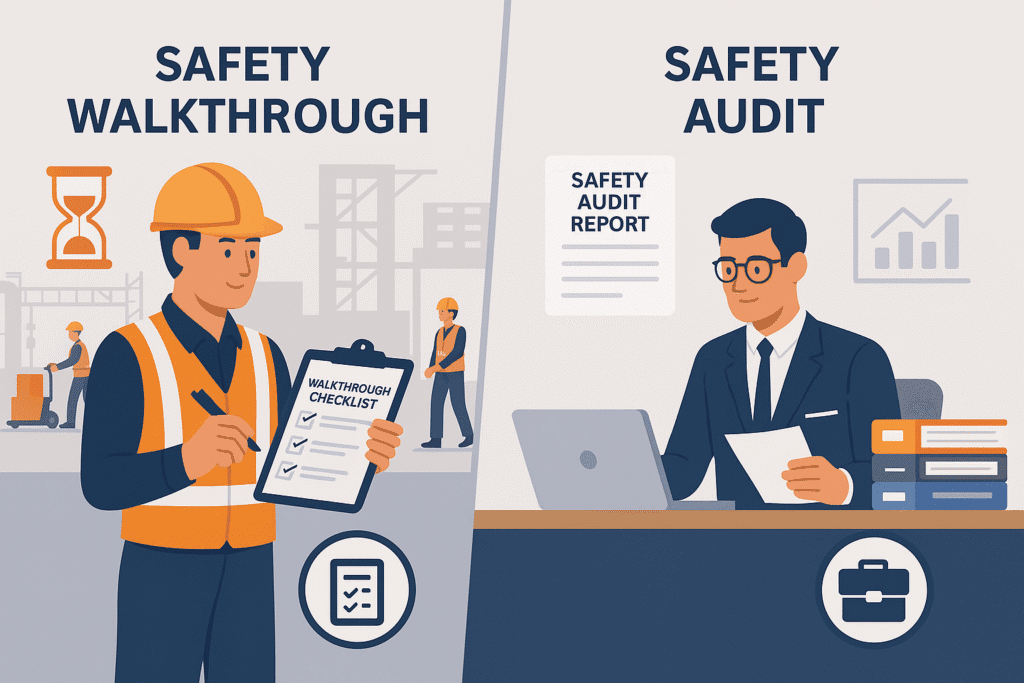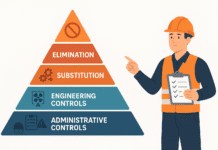
Safety Walkthrough vs Safety Audit
Every organization that values workplace safety must have systems in place to identify and control hazards. Two commonly used approaches for evaluating workplace safety performance are the Safety Walkthrough and the Safety Audit.
Although these terms are often used interchangeably, they have different objectives, levels of detail, and outcomes. Understanding the difference between a safety walkthrough and a safety audit ensures that both are used effectively to strengthen the organization’s health, safety, and environmental (HSE) performance.
In this complete guide, we’ll cover:
- What a safety walkthrough is
- What a safety audit is
- The key differences between the two
- When and how to conduct each
- Benefits, examples, and best practices
What is a Safety Walkthrough?
A Safety Walkthrough (also called a Safety Inspection or Site Walk) is a quick, informal, and regular visual examination of the workplace to identify unsafe conditions, unsafe acts, or potential hazards.
It focuses on day-to-day operational safety and helps ensure that workers follow safe practices.
Objective:
To identify visible unsafe conditions or acts and correct them immediately before they cause an incident.
Key Features:
- Informal and short in duration (typically 30–60 minutes).
- Conducted frequently (daily, weekly, or monthly).
- Performed by supervisors, safety officers, or managers.
- Focuses on visible compliance and housekeeping.
Example:
A site engineer and safety officer walk through a construction area to check:
- Workers wearing PPE.
- Scaffolds properly tagged.
- Cables not lying across walkways.
- Fire extinguishers accessible and charged.
If issues are found, they are corrected immediately, and a short report is submitted for recordkeeping.
What is a Safety Audit?
A Safety Audit is a comprehensive, systematic, and formal examination of an organization’s entire safety management system, policies, and procedures to evaluate compliance and effectiveness.
It goes beyond visible hazards — it assesses documentation, processes, and organizational culture.
Objective:
To evaluate the effectiveness of the safety management system (SMS) and ensure compliance with legal, organizational, and international standards.
Key Features:
- Formal and detailed in nature.
- Conducted periodically (quarterly, semi-annually, or annually).
- Performed by trained internal or external auditors.
- Includes documentation review, interviews, and physical verification.
- Produces a detailed report with findings and corrective actions.
Example:
An HSE audit in a manufacturing plant may include:
- Reviewing risk assessments and incident reports.
- Checking training records and permits.
- Interviewing employees on safety awareness.
- Inspecting fire systems, emergency exits, and storage facilities.
The audit identifies systemic gaps rather than immediate unsafe acts.
Safety Walkthrough vs Safety Audit: Key Differences
Below is a detailed comparison table that highlights the key distinctions between a Safety Walkthrough and a Safety Audit:
| Parameter | Safety Walkthrough | Safety Audit |
|---|---|---|
| Purpose | To identify visible hazards and unsafe acts in daily operations. | To evaluate the overall effectiveness of the safety management system. |
| Nature | Informal, quick observation. | Formal, systematic evaluation. |
| Frequency | Frequent (daily/weekly). | Periodic (quarterly/annually). |
| Scope | Limited to specific areas or activities. | Comprehensive — covers entire organization or project. |
| Conducted By | Supervisors, safety officers, or line managers. | Internal or external qualified auditors. |
| Duration | 30 minutes to a few hours. | Several days, depending on scope. |
| Focus | Immediate hazards, PPE compliance, housekeeping. | Policies, procedures, training, legal compliance, safety culture. |
| Documentation | Brief checklist or observation sheet. | Detailed audit report with non-conformities and corrective action plan. |
| Output | On-the-spot corrections and short-term improvements. | Long-term strategic recommendations for system improvement. |
| Follow-up | Immediate feedback and rectification. | Corrective and preventive action (CAPA) with management review. |
| Example | Checking scaffold tags and fire extinguisher placement. | Reviewing permit-to-work procedure effectiveness and training records. |
In Simple Terms
- Safety Walkthrough = “Are we following the safety rules today?”
- Safety Audit = “Do we have the right safety rules, systems, and culture in place?”
Example Scenarios
Scenario 1 – Unsafe Scaffolding
Walkthrough Finding:
A supervisor notices that a scaffold lacks toe boards and immediately instructs the team to fix it.
Audit Finding:
The auditor identifies that the company lacks a documented scaffold inspection checklist — a systemic issue requiring policy improvement.
Scenario 2 – PPE Non-Compliance
Walkthrough:
A safety officer notices workers not wearing gloves during rebar work and corrects them instantly.
Audit:
The audit reveals that the PPE issuance records are outdated and no refresher training has been conducted in six months.
Steps to Conduct a Safety Walkthrough
A walkthrough should be simple, quick, and action-oriented.
Step 1: Prepare the Checklist
Use a site-specific checklist that covers:
- PPE compliance
- Housekeeping
- Machinery condition
- Fire and emergency systems
- Electrical safety
- Material storage and access
Step 2: Conduct the Walkthrough
Walk through all work areas, observe activities, interact with workers, and note observations.
Step 3: Record Findings
Use simple categories: Safe / Unsafe / Needs Improvement.
Step 4: Take Immediate Action
Correct unsafe conditions or report issues requiring maintenance.
Step 5: Review and Report
Share findings with supervisors and record corrective actions in a log.
Tip: Keep walkthroughs short and regular — consistency matters more than duration.
Steps to Conduct a Safety Audit
A safety audit is more structured and involves documentation and verification.
Step 1: Define Audit Scope and Objectives
Specify departments, sites, or processes to be covered.
Step 2: Prepare the Audit Plan
Include audit schedule, team members, checklists, and criteria (legal, ISO, company policy).
Step 3: Conduct Document Review
Check HIRA, permits, training, incident records, emergency procedures, etc.
Step 4: Perform Field Verification
Inspect workplaces and verify whether documented procedures are followed.
Step 5: Interview Employees
Assess their safety awareness and training effectiveness.
Step 6: Record Non-Conformities
Classify as Major, Minor, or Observation.
Step 7: Report and Follow-up
Prepare an audit report, assign responsibilities, and track corrective actions (CAPA).
Tip: Always involve management in closing audit findings — accountability drives improvement.
Benefits of Each Approach
Benefits of Safety Walkthroughs
✔ Quick detection of unsafe conditions.
✔ Immediate corrective actions.
✔ Promotes safety awareness among workers.
✔ Enhances supervisor involvement in safety.
✔ Encourages teamwork and ownership.
Benefits of Safety Audits
✔ Evaluates the effectiveness of the safety management system.
✔ Ensures legal and standard compliance.
✔ Identifies long-term gaps and process failures.
✔ Provides measurable safety performance indicators.
✔ Builds organizational confidence and transparency.
How They Work Together
Safety walkthroughs and audits are complementary tools, not alternatives.
- Walkthroughs handle immediate operational hazards.
- Audits handle systemic and procedural improvements.
In a strong safety management system:
- Daily Walkthroughs → identify & correct visible issues.
- Weekly Inspections → track recurring issues.
- Monthly/Quarterly Audits → review overall safety effectiveness.
Together, they create a closed safety feedback loop.
Example: Integrated Safety Monitoring System
| Frequency | Activity | Conducted By | Purpose |
|---|---|---|---|
| Daily | Safety Walkthrough | Supervisor / Safety Officer | Detect and fix daily hazards |
| Weekly | Departmental Inspection | Safety Team | Monitor compliance trends |
| Quarterly | Internal Safety Audit | HSE Manager | Assess system effectiveness |
| Annually | External Safety Audit | Third-Party Auditor | Verify legal and ISO compliance |
Common Mistakes to Avoid
- Conducting walkthroughs without action tracking – record findings and follow up.
- Treating audits as blame games – focus on improvement, not fault-finding.
- Not involving management – lack of accountability reduces impact.
- Skipping trend analysis – repeated issues mean systemic failure.
- Using generic checklists – tailor to each site’s unique hazards.
Internal Links
- Construction Site Risk Assessment: Key Hazards and Controls
- Common Mistakes in HIRA and How to Avoid Them
- Fire Risk Assessment in the Workplace – Complete Guide
- Emergency Response Plans: What Every Facility Should Include (and Often Misses)
- Behavior Based Safety Programs: How to Design, Implement, and Sustain for Workplace Excellence
External References
For checklist and templates visit The HSE Tools.
Conclusion
Both Safety Walkthroughs and Safety Audits play essential roles in maintaining workplace safety — but they serve different purposes.
- Walkthroughs are quick, routine, and focus on immediate visible hazards.
- Audits are formal, detailed, and evaluate the long-term effectiveness of safety systems.
When used together, they form a comprehensive safety monitoring system that ensures compliance, reduces incidents, and fosters a proactive safety culture.
“Walkthroughs fix today’s problems. Audits prevent tomorrow’s.”






















